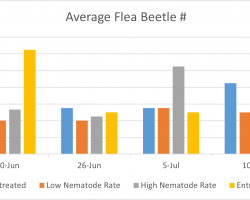Background & Objectives
Flea beetle adults lay their eggs at the base of brassica plants after mating. The eggs hatch and larvae feed on the fine roots for several weeks, pupate, and adults re-emerge from the soil to find new brassica leaf tissue to eat. Studies have shown that nematodes in the families Steinermena and Heterorhabditidae can attack the larval stage of flea beetles in the soil, thereby reducing the overall size of the population within a field over time. We wanted to know if this strategy would cause noticeable results in a real field, and try to estimate the impact on flea beetle survival and reproduction. We used a mixture of Steinermena carpocapsae plus Heterorhabditis bacteriophora nematodes applied to the soil as a drench at the base of the plants and monitored adult flea beetle emergence from the soil over the following 5 weeks.
Our treatments were:
- Untreated control
- Low rate: 5 x 107 nematodes/2500 sq. ft. (600,000 nematodes per plot)
- High rate: 5 x 107 nematodes/1000 sq. ft. (1,500,000 nematodes per plot)
- Entrust SC at 10 fl oz/A (labeled rate for root maggot suppression via soil application)
Methods
‘Green Magic’ broccoli (Johnny’s Selected Seeds, ME) was started in the greenhouse on April 24. On June 24th 100# N/A organic fertilizer (7-2-4) was applied and broccoli was transplanted by hand into staggered double rows 18 in. apart and 11 in. in-row spacing. One line of drip tape was used to maintain adequate soil moisture but no mulch was used, so that we could later apply treatments to the soil and could monitor adult flight out of the soil. Borisol was applied on June 1, 8, and 30th. We ordered commercial nematodes from Koppert Biological Systems and on June 15th, the nematodes were reconstituted in water and we looked at the solution under the microscope to ensure the nematodes were alive and to quantify them accurately. We also checked that the treatment application method was not lethal to the nematodes by spraying the solution into a beaker and re-checking the percentage of living versus dead nematodes in the sprayed solution. The field was divided up into four replications of each of the four treatments, with plots consisting of 10 ft. of bed with a 5 ft. buffer in between. We then applied the treatments using a CO2-powered backpack sprayer with a Floodjet nozzle (TeeJet TK-7.5) and no filter, set to 15 PSI. We then setup emergence cages, which consisted of no-se’em netting sewn into a tube with 1 ft. diameter metal ring base, over individual broccoli plants to capture flea beetles as they emerge from the soil below over time. We monitored emergence of the adult beetles by placing a yellow sticky card inside the trap and checking the card once per week and recording the numbers of beetles present over time. We also happened to capture cabbage root maggot flies emerging on some days. There was one trap per plot. No harvest or yield data was recorded because the plants were damaged from heat waves that occurred during head formation and most crowns were not marketable.
Results & Discussion
There were no significant differences between any treatments, on any of the collection dates. This might be because we didn’t get the timing right (we would want the nematodes to be present when larvae are present in soil but are not too old) or because we did not have enough traps to detect small differences. Next year we hope to repeat this experiment using more traps and repeating each application to increase the chances that active nematodes are present when flea beetle larvae are at the correct life stage.
This trial was repeated in 2019: Click here to view the 2019 trial report.
This material is based upon work supported by the National Institute of Food and Agriculture, U.S. Department of Agriculture, through the Northeast Sustainable Agriculture Research and Education program under subaward number LNE18-365.



